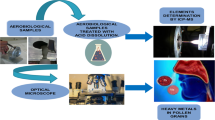Abstract
According to several reports, the presence of transition metal elements in the atmosphere was associated with adverse health effects. The purpose of this investigation was to analyze the presence of transition metal particles with atomic numbers 22–29 on some medicinal plants (n = 22) from various regions of the Republic of Tajikistan and their content in the atmosphere. Samples (n = 43) of individual plant organs, such as seeds, flowers, leaves, trunks, and plant roots, were examined for their elemental composition using X-ray fluorescence analysis. Selection of particles contained in the atmosphere was carried out for 24 h/3 days by the aspiration method using fiberglass filters GF 10 in an apparatus installed at an altitude of 864 m on the periphery of the capital. For the analysis of plant samples, measurements were carried out on a SPECTROSCAN MAX-G wave-dispersive X-ray fluorescence spectrometer. For samples containing filtered atmosphere elements, a high-resolution PANanalytical Epsilon 5 high-resolution energy-dispersive spectrometer was used. Eight transition elements from the 1st main series of metals with atomic numbers 22–29, such as titanium, vanadium, chromium, manganese, iron, cobalt nickel, and copper, were found in plant organs, as well as in the atmosphere samples. Our results showed that the distribution of metals on plants varied depending on plants and their organs. We did not find any correlation between the region of plant collection and their absorption of metal elements. The distribution of metals varied in various plant organs. In the atmosphere samples, we found all the metals that were found in plants. In conclusion, medicinal plants can adsorb and accumulate some harmful chemical elements in their organs, are involved in the recirculation of these metals, and contribute air pollution.


Similar content being viewed by others
References
Abdullaev, S. F., Eleftheriadis, K., Temur, F., Manousakas, M., Juraev, A. M., & Kantarelou, V. (2017). Study of the content of elements in atmospheric aerosol. Vestnik TNU, 1(3), 177–184.
Costa, D. L., & Dreher, K. L. (1997). Bioavailable transition metals in particulate matter mediate cardiopulmonary injury in healthy and compromised animal models. Environmental Health Perspectives, 105(Suppl5), 1053–1060. https://doi.org/10.1289/ehp.97105s51053.
Dreher, K. L., Jaskot, R. H., Lehmann, J. R., Richards, J. H., McGee, J. K., Ghio, A. J., & Costa, D. L. (1997). Soluble transition metals mediate residual oil fly ash induced acute lung injury. Journal of Toxicology and Environment Health, 50(3), 285–305.
Gao, J., Kim, Y. D., Liang, L., Idrobo, J. C., Chow, Ph., Tan, J., et al. (2016). Transition metal substitution doping in synthetic atomically thin semiconductors. Advanced materials, 28(44), 9735–9743. https://doi.org/10.1002/adma.201601104.
Grigoriev, A. A., Borodikhin, A. S., Rudenko, O. V., & Sova Yu, A. (2013). An experiment to identify a model of hyperaccumulation of heavy metals with Jerusalem artichoke during soil phytoremediation. - Modern problems of science and education, No 6. [in Russian].
Habre, R., Fruin, S., Gauderman, J., Lurmann, F., Gilliland, F., McConnell, R., & Urman, R. (2016). Exposure to transition metals in particulate matter air pollution and children’s lung function in the Southern California Children’s Health Study. In B15. health effects of indoor/outdoor pollution in childhood (pp. A2873-A2873). American Thoracic Society. https://www.orexca.com/rus/tajikistan/history.htm
Kodavanti, U. P., Schladweiler, M. C., Richards, J. R., Costa, D. L. (2001). Acute lung injury from intratracheal exposure to fugitive residual oil fly ash and its constituent metals in normo- and spontaneously hypertensive rats. Inhal Toxicol, Jan;13(1):37–54.Transition element [archive] », IUPAC, Compendium of Chemical Terminology.
Lewis, A. B., Taylor, M. D., Roberts, J. R., Leonard, S. S., Shi, X., & Antonini, J. M. (2003). Role of metal-induced reactive oxygen species generation in lung responses caused by residual oil fly ash. Journal of Biosciences, 28(1), 13–18.
Magnani, N. D., Marchini, T., Garcés, M., Mebert, A., Cáceres, L., Diaz, L., Desimone M, & Evelson, P. A. (2016). Role of transition metals present in air particulate matter on lung oxygen metabolism. The International Journal of Biochemistry & Cell Biology, : 81(B); 419–426
Mc Naught, A. D., Wilkinson A. Blackwell Scientific Publications, Oxford (1997). XML on-line corrected version: http://goldbook.iupac.org (2006-) created by M. Nic, J. Jirat, B. Kosata; updates compiled by A. Jenkins. ISBN 0–9678550–9–8. https://doi.org/10.1351/goldbook
Sadovnikova, L.K. (2006), Ecology and environmental protection during chemical pollution. Moscow: Higher school, 334 p. [in Russian]
Acknowledgements
We would like to thank Konstantinos Eleftheriadis and staff (E.R.L., Institute of Nuclear and Radiological Sciences and Technology, Energy and Safety, N.C.S.R. Demokritos, Attiki, Greece) for analysis of aerosol samples and International Science and Technology Centre (ISTC) for support of T-1688 and T-2076 Projects.
Author information
Authors and Affiliations
Corresponding author
Ethics declarations
Conflict of interest
The authors declare that they have no conflict of interest.
Additional information
Publisher’s Note
Springer Nature remains neutral with regard to jurisdictional claims in published maps and institutional affiliations.
Rights and permissions
About this article
Cite this article
Sharofova, M., Abdullaev, S., Maslov, V. et al. First main series of transition elements with atomic numbers from 22 to 29, found in air pollution and detected in the plants from Tajikistan areas. Environ Monit Assess 193, 127 (2021). https://doi.org/10.1007/s10661-021-08909-2
Received:
Accepted:
Published:
DOI: https://doi.org/10.1007/s10661-021-08909-2




